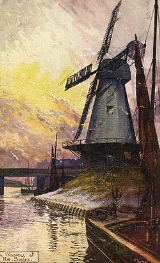
Gibbet Mill, Rye
Encyclopedia
Gibbet Mill, Tillingham Mill, Barry's Mill or New Mill is a grade II listed cosmetically reconstructed smock mill
at Rye
, Sussex
, England
. Today it serves as bed and breakfast accommodation.
is known to have been built here in 1758. Gibbet Mill was built in 1824, the name Barry's mill coming from an early miller. The mill was working by wind until 1912, and was used as a bakery until 13 June 1930 when it was burnt down. The new mill was erected in 1932, Neve's of Heathfield
being responsible for the millwright
ing work.
but latterly was worked with four Spring sails. These were carried in a cast iron
Windshaft. The cap was in the Kentish style, winded by a fantail
. The mill drove three pairs of millstone
s.
The replica mill has a shorter smock, making the mill appear squatter than the original. The cap is exaggerated in height and is not designed to turn into the wind. Replica sails and fantail are carried. The reconstructed stage is wider than the original.
References for above:-
Smock mill
The smock mill is a type of windmill that consists of a sloping, horizontally weatherboarded tower, usually with six or eight sides. It is topped with a roof or cap that rotates to bring the sails into the wind...
at Rye
Rye, East Sussex
Rye is a small town in East Sussex, England, which stands approximately two miles from the open sea and is at the confluence of three rivers: the Rother, the Tillingham and the Brede...
, Sussex
Sussex
Sussex , from the Old English Sūþsēaxe , is an historic county in South East England corresponding roughly in area to the ancient Kingdom of Sussex. It is bounded on the north by Surrey, east by Kent, south by the English Channel, and west by Hampshire, and is divided for local government into West...
, England
England
England is a country that is part of the United Kingdom. It shares land borders with Scotland to the north and Wales to the west; the Irish Sea is to the north west, the Celtic Sea to the south west, with the North Sea to the east and the English Channel to the south separating it from continental...
. Today it serves as bed and breakfast accommodation.
History
A mill has stood on this site since 1596, and a post millPost mill
The post mill is the earliest type of European windmill. The defining feature is that the whole body of the mill that houses the machinery is mounted on a single vertical post, around which it can be turned to bring the sails into the wind. The earliest post mills in England are thought to have...
is known to have been built here in 1758. Gibbet Mill was built in 1824, the name Barry's mill coming from an early miller. The mill was working by wind until 1912, and was used as a bakery until 13 June 1930 when it was burnt down. The new mill was erected in 1932, Neve's of Heathfield
Heathfield, East Sussex
Heathfield is a small market town, and the principal settlement in the civil parish of Heathfield and Waldron in the Wealden District of East Sussex, within the historic County of Sussex, England.-Location:...
being responsible for the millwright
Millwright
A millwright is a craftsman or tradesman engaged with the construction and maintenance of machinery.Early millwrights were specialist carpenters who erected machines used in agriculture, food processing and processing lumber and paper...
ing work.
Description
As built, Gibbett Mill was a four storey smock mill on a single storey brick base, with a stage at first floor level. In 1844 she had four Patent sailsWindmill sail
Windmills are powered by their sails. Sails are found in different designs, from primitive common sails to the advanced patent sails.-Jib sails:...
but latterly was worked with four Spring sails. These were carried in a cast iron
Cast iron
Cast iron is derived from pig iron, and while it usually refers to gray iron, it also identifies a large group of ferrous alloys which solidify with a eutectic. The color of a fractured surface can be used to identify an alloy. White cast iron is named after its white surface when fractured, due...
Windshaft. The cap was in the Kentish style, winded by a fantail
Windmill fantail
A Fantail is a small windmill mounted at right angles to the sails, at the rear of the windmill, and which turns the cap automatically to bring it into the wind. The fantail was patented in 1745 by Edmund Lee, a blacksmith working at Brockmill Forge near Wigan, England, and perfected on mills...
. The mill drove three pairs of millstone
Millstone
Millstones or mill stones are used in windmills and watermills, including tide mills, for grinding wheat or other grains.The type of stone most suitable for making millstones is a siliceous rock called burrstone , an open-textured, porous but tough, fine-grained sandstone, or a silicified,...
s.
The replica mill has a shorter smock, making the mill appear squatter than the original. The cap is exaggerated in height and is not designed to turn into the wind. Replica sails and fantail are carried. The reconstructed stage is wider than the original.
Millers
- Frederick Barry 1824 - 1844
- John Smith 1848 - 1879
- Gorge Standed 1882 - 1899
- Webb 1917
References for above:-
External links
- Windmill World Page on Gibbet windmill.
- Rye Windmill B&B website.

